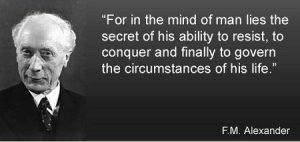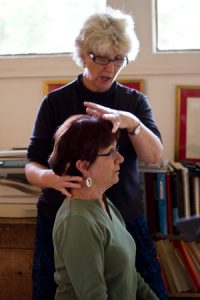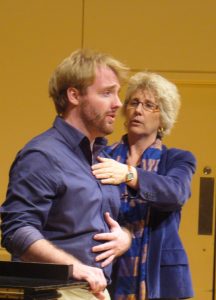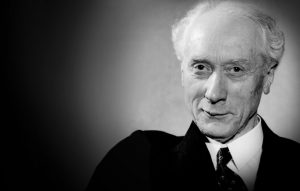
The Alexander Technique is….
a way to free yourself from habits that limit movement, cause pain,
or restrict expressive potential
a way back to the joy we all had as children
a way to un-learn unconscious responses to stress

a way to improve breathing
My Alexander Journey
I first became interested in Alexander Technique when I was doing my MM in Vocal Performance at Carnegie-Mellon University in Pittsburgh. Knowing that I struggled with performance anxiety, my beloved voice teacher, Mimi Lerner, suggested that I have a course of lessons. I walked out of my first Alexander lesson with CMU’s Pam Lewis that day feeling so light, free, and floating I hardly recognized myself. Long-standing patterns of tension and anxiety seemed to have let go. I felt easier in the way I walked, the way I sang, the way I did anything.
What had happened? This was the question that launched the quest.
In Pittsburgh I had many lessons with Pam Lewis, Carolyn Johnston, and other Alexander Technique teachers and knew that eventually I wanted to train to teach this work. Then in 2012 I saw the announcement of the training course at the Alexander Technique Center at Boston Conservatory headed by Debi Adams and I knew that this was my chance. A three-year, 1600-hour 27,000-miles-of-driving commitment was in store. I graduated in 2015 and passed the sponsorship to become a Certified Teaching Member of Alexander Technique International in 2018.

What is this thing called the Alexander Technique?
The Alexander Technique is a way to become aware of what we are doing as we are doing it.
With that awareness, we can choose freedom in our doing.
It is an educational process. We can learn to notice our own patterns of interference in the moment, before those patterns cause injury, premature debilitation, restrict our creative range as performers, or add to plain old unhappiness and lack of fulfillment.
Scenario:
Have you ever spent two hours in front of a computer or working in your garden and gotten up in the full realization that your back is killing you and your neck is aching? Your poor body had probably been trying to get your attention for hours, but you didn’t notice. Or maybe you are a violinist or an actor who feels curiously disconnected from your self when you perform, or you carry physical and mental tension that you just know is impeding your work on stage.
The good news is that we can learn to notice our selves and what we’re up to, before our habits cause too much havoc. As my colleague Bob Lada who teaches the Alexander Technique at Berklee College of Music puts it, it’s about noticing how we do what we do.
What is a typical Alexander Technique lesson like?
Well, if it’s about how we do what we do, then we start with what you’re doing – ie. an activity. That can be as simple as standing up or sitting down in a chair, putting on your shoes, or as complex as singing an opera aria or playing the violin. While some specific exercises and procedures can be a part of an Alexander lesson, they are never the focal point. As you, the student, practice your activity, I, the teacher, use gentle touch with my hands and my words as a reference point for you to notice movement potential you hadn’t realized was there all along.
Sometimes we will work in semi-supine position on a table. That’s just because noticing and releasing can often happen more easily when you take the work of standing up out of the gravitational field. You should wear fluid lightweight clothes that you can move easily in to a lesson.
In the course of a lesson, we may address your body map, ie. your ideas about how you are anatomically structured, so that you understand clearly how you are constructed to move. If you are interested in this aspect of the work more, check out the work of Barbara Conable who along with her husband William invented “Body Mapping” as a separate entity of study. You’ll find information in the links section of this website.
What Alexander Technique Isn’t
While the pain of misuse or dysfunction may bring you into the Alexander studio, the work is not about fixing anything. It’s not chiropractic or massage or physical therapy or any other manipulative intervention. AT can be a valuable asset to anyone who is undergoing or recovering from these kinds of interventions, but it is essentially not a therapeutic procedure, but an educational one. Many people think Alexander Technique is about fixing poor posture. Well, yes, sort of…for sure, your posture will doubtless improve during a course of lessons, but this improvement is a result of freedom from habitual contraction.
Ultimately, as in every educational endeavor, the work’s success depends upon the student’s commitment to the learning process. Alexander work has been called a “pre-technique;” in other words, you can take the learned principles of the Alexander Technique into all your activities – ones as mundane as peeling carrots at the sink, or movement practices of yoga, Pilates, sports, dance, voice work, acting, rock-climbing. As we know, caring for children and the elderly are also demanding activities where Alexander Technique can be a lifeline to more peaceful ways to nurture others. Literally, anything humans do can benefit from the freedom from habit that AT offers.
The goal of the work is for you to notice what you are doing in the moment so that a range of choices is available to you beyond your habit. I have worked with students singing, knitting, carving woodblocks, playing the flute, speaking a monologue, putting on their socks, learning how to maintain their cool when dealing with a teenager trying to push their buttons, working in the garden…there is not a human activity beyond the scope of the Alexander Technique.

How did this whole thing start and who was F.M. Alexander?
He was an Australian actor born in 1869. He was the in the midst of a burgeoning career as a Shakespearean monologist, and he began to have a perplexing problem. He started to lose his voice in the middle of his performance. (As a voice teacher, I’m pretty interested in the fact that the whole Technique began specifically with a voice problem!) To cut a long story short, no doctors were able to help him, because after their prescriptions for vocal rest or medicines were over, and he went back to performing again, midway through the evening’s performance he would start to get hoarse again. So he reasoned that it was something he was doing to himself, the way he was using himself as he spoke that was causing the problem.
This is a fundamental principle of the Technique – use affects function. ie. How we do what we do affects the outcome. To paraphrase my colleague Trevor Sohnen, it’s kind of like what would happen if you have the habit of driving your car over speed bumps too fast for years and years until it finally breaks down and you take it into the shop and the guy replaces the shocks. But if you keep driving the same way, the same thing will happen, right? How you drive affects the condition of the car. Use affects function. So, if we wouldn’t do this to our car, why would we do this with our selves?
So, back to F.M. Alexander. He set up a bunch of mirrors in his living room and observed himself. For about seven years. And the fruit of his observation was this: he noticed that just as he began to speak he had a habit of tightening his neck and pressing down his head on top of his spine which interfered with his breath and vocal function. He had absolutely no idea he had been doing this. The habit was entirely subconscious. In fact, that’s a working definition of habit, right? Something we do which we are not aware of. In the process of this self-observation, Alexander articulated for the first time what has since been confirmed by science – that in all vertebrates, the relation of the head to the spine is the locus of the primary movement potential. There’s a reason why a horse can be controlled by reins which guide the direction and freedom of its head. You pull back on the reins and the horse can’t move forward. Alexander called the head-spine relationship in humans the primary control. I tend to stay away from the word “control” as it suggests direct manipulation, which is not what we’re up to in Alexander work. I speak of primary balance or primary relationship. To release any tensional interference with freedom in that primary relationship in everything we do is the center of this work.
So, having observed this habitual misuse, Alexander’s next dilemma was how to change it. And this is where he made his biggest discovery, the discovery that makes Alexander work revolutionary. If he tried to “fix” his misuse directly, ie. if he put his head in the “right” position, he ended up feeling just as tense as before. This didn’t change anything. (I bet many of you have experienced this – has a teacher or parent ever observed you slumped in a chair and barked “Sit up straight!” and so you yank yourself up military style but it doesn’t feel any better, right?)
But, then F.M. (as he’s called in the biz) had another insight: if in the moment that he had the stimulus to speak, he instead paused long enough to withhold consent from his habit, and he refused to pull his head back and down, then a new way of free speaking emerged from that moment. He called this moment of pause ” inhibition”, and it is what makes Alexander Technique different from anything else.
Inhibition…
…Wait a minute – I thought “inhibition” was a bad thing?
-Not in Alexander work.
When F.M. Alexander began to teach and write about his discovery, he used the word in its neurological and medical sense, ie. Inhibition is the stopping of a reaction (for example, in a chemical experiment, ie…you have a pot of boiling water…you pour cold water into the pot…the boiling stops…the cold water has inhibited the boiling reaction.) In our bodies when we want to move, nerves cause chemical messages that can either stimulate our muscles to contract or inhibit muscular response. We also see inhibition at work in nature – think of a cat pausing in the crouch as she waits for the right moment to pounce. Or think of when we hold a fragile object – we actively withhold any tension in our hands that might crush it. This is inhibition at work.
(Sigmund Freud used this word “inhibition” in a very different way to mean the suppression of instinct. It is somewhat unfortunate that this usage has entered into our common vocabulary. It is a fascinating comparison between these two great 19th century pioneers, for Freud spent much of his clinical life documenting the ills that this “suppression of instinct” caused, while Alexander spent his life creating a practical path for the conscious reasoning mind to overcome habituated instinctual reaction.)
Direction
When our minds are engaged in the present moment, and fully engaged in the world through the Broad Field of Awareness, we can learn to think actively, or direct ourselves in ways of free movement.
F.M. Alexander spoke of the primary directions as
“I will allow my neck to be free, so that
My head can move forward and up, so that
My back can lengthen and widen……………………………………………all together, and one after the other.”
Exploring what these primary directions feel like, and how we can use this thinking to become more balanced and poised is a valuable part of any Alexander Technique lesson. Teachers have different ways of working with direction. But the goal of ease in both our thinking and our movement is the same.
